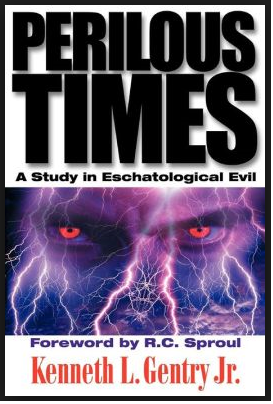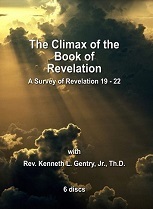DOMITIAN’S PERSECUTION (AGAIN)
PMW 2024-052 by Kenneth L. Gentry, Jr.
I keep hearing and reading folks referring to Domitian’s severe persecution of Christians, claiming that it was much more severe and widespread than Nero’s earlier persecution. This is significant in light of the debate over the dating of Revelation. Late-date advocates argue that Revelation was written about the intense persecution under the emperor Domitian. Whereas early date advocates argue that it was written prior to Nero’s persecution twenty years earlier.
I have found that too often people are simply regurgitating what they have heard someone else say. They do this as if it were self-evident that Nero’s persecution paled in comparison to Domitian’s. But when we read many competent biblical and historical scholars, we see a serious diminishing of this proposed understanding of early persecution. In this article I will simply cite a few academic sources that should discourage us from simply assuming Domitian was a great persecutor, a beast . . . in fact, the beast of Revelation.
Consider the following comments by reputable scholars.
I will begin with an important paper written expressly on this point. Barclay Newman published his study, “The Fallacy of the Domitian Hypothesis: Critique of the Irenaeus Source as a Witness for the Contemporary Historical Approach to the Interpretation of the Apocalypse.” This was published in the academic journal, New Testament Studies (10:1, October 1963), pages 133-39. Newman explodes the myth of the Domitianic persecution. This can be found at:
https://www.cambridge.org/core/journals/new-testament-studies/article/abs/fallacy-of-the-domitian-hypothesis-critique-of-the-irenaeus-source-as-a-witness-for-the-contemporary-historical-approach-to-the-interpretation-of-the-apocalypse/899CC2AC9AB3B64DFF836944AE223BB7
BEFORE JERUSALEM FELL
Doctoral dissertation defending a pre-AD 70 date for Revelation’s writing (459 pp; paperback). Thoroughly covers internal evidence from Revelation, external evidence from history, and objections to the early date by scholars.
For more study materials: https://www.kennethgentry.com/
Shortly thereafter, the (non-dispensational) premillennial scholar George E. Ladd wrote his A Commentary on the Revelation of John (Eerdmans, 1972). On pages 8–9 we read: “Tradition has ascribed the Revelation to the last decade of the first century when Domitian was emperor in Rom (A. D. 81–96).” He goes on to say: “The problem with this theory is that there is no evidence that during the last decade of the first century there occurred any open and systematic persecution of the church…. The alleged persecution by Domitian was by no means empire-wide but was directed against a few families in Rome.”

Blessed Is He Who Reads: A Primer on the Book of Revelation
By Larry E. Ball
A basic survey of Revelation from an orthodox, evangelical, and Reformed preterist perspective. Ball understands John to be focusing on the destruction of Jerusalem and the temple in AD 70. Insightful. Easy to read.
For more Christian studies see: www.KennethGentry.com
The noteworthy Introduction to the New Testament by Carson, Moo, and Morris (Zondervan 1992) notes similarly: “Advocates of the Domitianic date have generally appealed to the early Christian tradition that picture the years 95–96 as a period of intense persecution…. Advocates of an early date have a point: many scholaris have exaggerated the evidence for a persecution of Christian under Domitian. The evidence suggests rather that Domitian in the last years of his reign instituted a purge of Roman aristocrats who might challenge his power” (p. 474).
C. F. D. Moule’s The Birth of the New Testament (Harper and Row, 1982, p. 153) concurs: “The alleged persecution under Domitian, to which the relevant passages of the Apocalypse are usually referred, cannot be established.”
Leon Morris’ “Tyndale New Testament Commentary” on Revelation (IVP 1987, p. 37), follows suit: “It is very difficult to find evidence that Domitian did in fact persecute people outside Rome. There is evidence of his having certain people executed there, such as Flavius Clemens and his wife Domitilla…. While later Christian speak of a persecution under Domitian the evidence is not easy to find.”
Stephen S. Smalley’s The Revelation to John (IVP 2005, p. 142) agrees with the preceding. He writes: “The severity of that oppression int the later part of the first Christian century, particularly under Domitian, has been questioned recently.” He cites Iain Boxall’s Revelation (pp. 98–104) and T. B. Slater’s “On the Social Setting of the Revelation to John” (New Testament Studies 44, 1988, pp. 232–56).
The Reformed Eschatology of Geerhardus Vos
Ed. by Ken Gentry and Bill Boney
This collection of several key eschatological studies by the renowned theologian Geehardus Vos will be published in late Summer or early Fall 2024. We have modernized Vos’ grammar and syntax and updated his publications according to modern style conventions (shorter sentences and paragraphs).
For information on the upcoming Geerhardus Vos work, see:
https://axeheadpress.com/pages/coming-soon-vos
I could continue. But I am weary. And supper is calling (I closely follow the Pauline love of food whereby he declares “I buffet my body”). I believe these few samples should at least turn the volume down somewhat on a Domitianic persecution as evidence for the late-date of Revelation.
Click on the following images for more information on these studies:



Kenneth L. Gentry Jr.'s Blog
- Kenneth L. Gentry Jr.'s profile
- 85 followers



